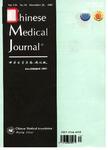Tenascin-C as a prognostic biomarker in osteosarcoma?
Tenascin-C as a prognostic biomarker in osteosarcoma?作者机构:Department of Orthopaedics Tongji Hospital Tongji Medical College Huazhong University of Science and Technology Wuhan Hubei 430030 China Department of Nuclear Medicine Tongji Hospital Tongji Medical College Huazhong University of Science and Technology Wuhan Hubei 430030 China
出 版 物:《Chinese Medical Journal》 (中华医学杂志(英文版))
年 卷 期:2009年第122卷第22期
页 面:2737-2743页
核心收录:
学科分类:090603[农学-临床兽医学] 090601[农学-基础兽医学] 1002[医学-临床医学] 09[农学] 0906[农学-兽医学]
基 金:This research was supported by a grant from the Scientific Research Foundation for the Returned Overseas Chinese Scholars State Education Ministry of China
主 题:osteosarcoma metastasis Tenascin-C
摘 要:Background Treating metastatic osteosarcoma has been challenged in past decades. Extracelluar matrix (ECM) proteins play an important role in the progression of osteosarcoma as they are pivotal components of the tumor microenvironment. Here, we identified potential genes belonging to the ECM and characterized the roles of these genes in the progression of osteosarcoma and their association with outcomes. Methods Osteosarcoma parental cell line MG63 and its derivative MG63-A1 with a high metastatic potential underwent oligonucleotide microarray analysis. Gene ontology analysis was used to screen deregulated genes between the 2 cell lines which were either upregulated or downregulated by more than 4 fold, particularly focusing on mRNAs encoding extracellular matrix proteins. The expression of resulting candidate genes was then validated by reverse transcription-PCR for mRNA expression as well as Western blotting for protein expression. Immunohistochemistry was performed on 37 osteosarcoma specimens to examine the potential role of the candidate genes in a clinical context. Results Microarray data and gene ontology analysis showed that Tenascin-C, a critical component of the ECM, is significantly down-regulated in the highly metastatic cell line MG63-A1 compared with the parental osteosarcoma cell line MG63-wt. This finding was validated at mRNA and protein levels. Immunohistochemical analysis found that Tenascin-C is located in the intercellular space in osteosarcoma specimens. Furthermore, low-grade Tenascin-C expression (less than 20%) in osteosarcoma specimens was associated with poor survival. Conclusions Tenascin-C expression level correlates with the survival of osteosarcoma patients. Its biological functional role and underlying molecular mechanisms in the progression of osteosarcoma needs further investigation.



